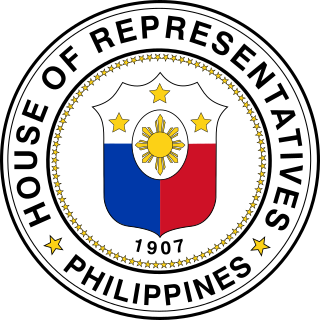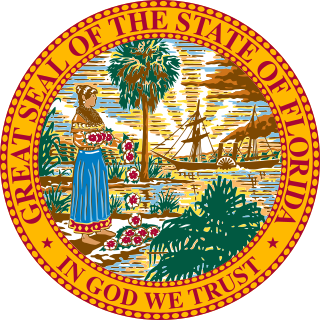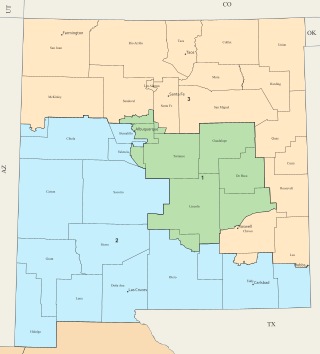
The House of Representatives of the Philippines is the lower house of Congress, the bicameral legislature of the Philippines, with the Senate of the Philippines as the upper house. The lower house is commonly referred to as Congress, although the term collectively refers to both houses.

The Florida Legislature is the legislature of the U.S. state of Florida. It is organized as a bicameral body composed of an upper chamber, the Senate, and a lower chamber, the House of Representatives. Article III, Section 1 of the Florida Constitution, adopted in 1968, defines the role of the legislature and how it is to be constituted. The legislature is composed of 160 state legislators. The primary purpose of the legislature is to enact new laws and amend or repeal existing laws. It meets in the Florida State Capitol building in Tallahassee.

The Florida House of Representatives is the lower house of the Florida Legislature, the state legislature of the U.S. state of Florida, the Florida Senate being the upper house. Article III, Section 1 of the Constitution of Florida, adopted in 1968, defines the role of the Legislature and how it is to be constituted. The House is composed of 120 members, each elected from a single-member district with a population of approximately 180,000 residents. Legislative districts are drawn on the basis of population figures, provided by the federal decennial census. Representatives' terms begin immediately upon their election.

The Arizona State Legislature is the state legislature of the U.S. state of Arizona. It is a bicameral legislature that consists of a lower house, the House of Representatives, and an upper house, the Senate. Composed of 90 legislators, the state legislature meets in the Capitol Complex in the state capital of Phoenix. Created by the Arizona Constitution upon statehood in 1912, the Arizona State Legislature met biennially until 1950. Today, they meet annually.

New Mexico's 1st congressional district of the United States House of Representatives serves the central area of New Mexico, including most of Bernalillo County, all of Torrance County, and parts of Sandoval, Santa Fe and Valencia counties. It includes almost three-fourths of Albuquerque. The district has a notable Native American presence, encompassing several pueblos including the Pueblo of Laguna and Sandia Pueblo, and the Tohajiilee Navajo Reservation outside Albuquerque. The seat is currently represented by Democrat Melanie Stansbury. With a Cook Partisan Voting Index rating of D+5, it is the most Democratic district in New Mexico, a state with an all-Democratic congressional delegation.
The 1848–49 United States House of Representatives elections were held on various dates in various states between August 1848 and November 1849. Each state set its own date for its elections to the House of Representatives before the first session of the 31st United States Congress convened on December 3, 1849. The new state of Wisconsin elected its first representatives, and California also held its first congressional elections before officially achieving statehood in 1850, increasing the size of the House to 233 seats.

The 1846–47 United States House of Representatives elections were held on various dates in various states between August 2, 1846, and November 2, 1847. Each state set its own date for its elections to the House of Representatives. 228 elected members representing 29 states took their seats when the first session of the 30th United States Congress convened December 6, 1847. The new states of Iowa and Texas elected their first representatives during this election cycle. These elections were held during President James K. Polk's term.

Since becoming a U.S. state in 1959, Alaska has been entitled to one member in the United States House of Representatives. The representative is elected at-large, because the state has only one congressional district, encompassing its entire territory. By area, Alaska's congressional district is the largest congressional district in the United States and the third-largest electoral district represented by a single member in the world. It is exceeded by Yakutsk district in Russia, which is similar in size to India and is the largest, and Nunavut, which comprises a single electoral district in Canada.
At large is a description for members of a governing body who are elected or appointed to represent a whole membership or population, rather than a subset. In multi-hierarchical bodies, the term rarely extends to a tier beneath the highest division. A contrast is implied, with certain electoral districts or narrower divisions. It can be given to the associated territory, if any, to denote its undivided nature, in a specific context. Unambiguous synonyms are the prefixes of cross-, all- or whole-, such as cross-membership, or all-state.

The politics of Oklahoma exists in a framework of a presidential republic modeled after the United States. The governor of Oklahoma is both head of state and head of government, and of a pluriform two-party system. Executive power is exercised by the governor and the government. Legislative power is vested in the governor and the bicameral Oklahoma Legislature. Judicial power is vested in the judiciary of Oklahoma. The political system is laid out in the 1907 Oklahoma Constitution.
The legislative districts of Davao Oriental are the representations of the province of Davao Oriental in the various national legislatures of the Philippines. The province is currently represented in the lower house of the Congress of the Philippines through its first and second congressional districts.
The legislative districts of South Cotabato are the representations of the province of South Cotabato and the urbanized city of General Santos in the various national legislatures of the Philippines. The province is currently represented in the lower house of the Congress of the Philippines through its first and second congressional districts.

New Mexico is divided into three congressional districts, each represented by a member of the United States House of Representatives.
Women have served in the United States House of Representatives, the lower chamber of the United States Congress, since 1917 following the election of Republican Jeannette Rankin from Montana, the first woman in Congress. In total, 376 women have been U.S. representatives and seven more have been non-voting delegates. As of November 28, 2023, there are 126 women in the U.S. House of Representatives, making women 29.0% of the total. Of the 383 women who have served in the House, 251 have been Democrats and 132 have been Republicans. One woman was the 52nd Speaker of the House, Democrat Nancy Pelosi of California.

The United States House of Representatives is the lower chamber of the United States Congress, with the Senate being the upper chamber. Together, they comprise the national bicameral legislature of the United States. The House is charged with the passage of federal legislation, known as bills; those that are also passed by the Senate are sent to the president for signature or veto. The House's exclusive powers include initiating all revenue bills, impeaching federal officers, and electing the president if no candidate receives a majority of votes in the Electoral College.

Stella Yvette Herrell is an American politician and realtor who served as the U.S. representative for New Mexico's 2nd congressional district from 2021 to 2023. A member of the Republican Party, she served four terms as a member of the New Mexico House of Representatives for the 51st district from 2011 to 2019.

Edgar Franklin Foreman Jr. was an American businessman and politician who was a member of the United States House of Representatives. He had one term representing Texas's 16th congressional district from 1963 to 1965 and a second term from 1969 to 1971 representing New Mexico's 2nd district, then newly established. He is the most historically recent member of Congress to have represented more than one state during their career.

The 2022 United States House of Representatives elections in New Mexico were held on November 8, 2022, to elect the three U.S. representatives from the state of New Mexico, one from each of the state's three congressional districts. The elections coincided with the New Mexico gubernatorial election and various state and local elections. The Democratic party gained the 2nd Congressional seat, gaining unitary control of New Mexico's Congressional delegation for the first time since 2018 and improving the advantage in the House delegation for New Mexico from 2–1 in favor of Democrats to 3–0.

On January 3, 2021, the 1st day of the 117th Congress and 2 months after the 2020 U.S. House elections, the incoming members of the U.S. House of Representatives held an election for speaker of the U.S. House of Representatives. It was the 127th U.S. speaker election since the office was created in 1789.

The Uniform Congressional District Act is a redistricting bill that requires that all members of the United States House of Representatives in the 91st United States Congress and every subsequent Congress be elected from a single member constituency unless a state had elected all of its previous representatives at large, where this requirement commenced for the 92nd United States Congress.
















